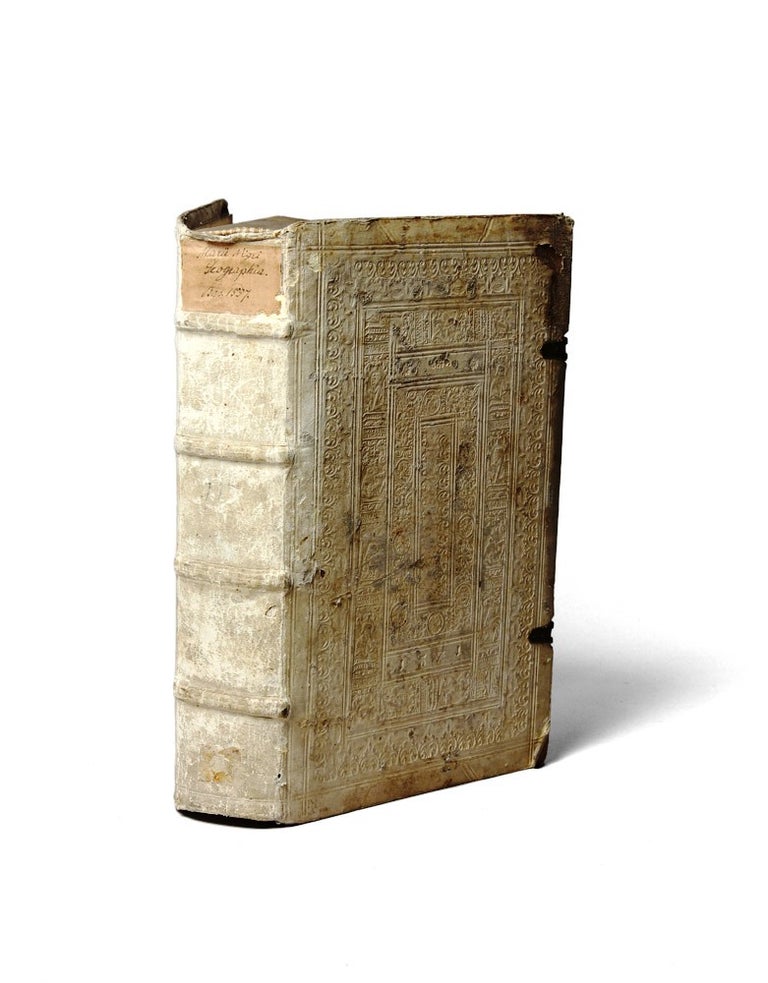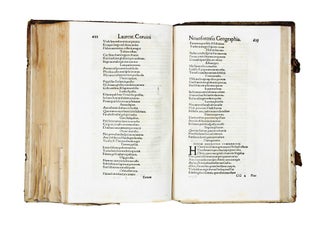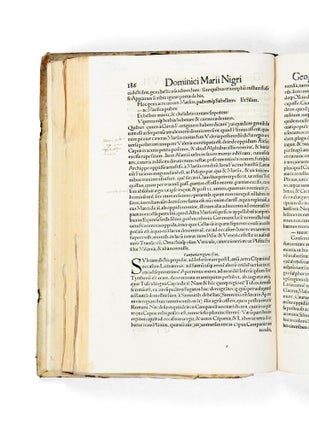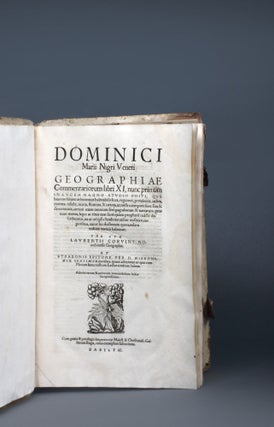Geographiae Commentariorum libri XI…
Dominici Marii Nigri Veneti Geographiae commentariorum libri XI: nunc primum in lucem magno studio editi… Una cum Laurentii Corvini novoforensis geographia. Et Strabonis epitome per D. Hieronymum Gemusaeum translata, quam adiecimus ut quo cum Marium hunc nostrum lector conferat, habeat.
Basle: Heinrich Petrus, March 1557.
Folio, woodcut printer's device to title and verso of final leaf, woodcut historiated initials; contemporary white pigskin over wooden boards, blind-tooled to a panelled design, roll-tooled borders including one with images of the psalmist and evangelists, another with humanist medallion portraits (including those of Erasmus, Luther and Melanchthon), spine with four raised bands, later paper label at head giving title in places.
"How many ways the Indian sea stretcheth itself"
First edition: a handsome copy in contemporary monastic pigskin binding of this mid-sixteenth century compendium of geographical knowledge by the Venetian writer Dominicus Marius Niger, edited by Wolfgang Wissenburg. In the tradition of the great classical geographer Strabo, Niger provides a description of the principal regions of the earth, together with accounts of the habits, customs and laws of its various peoples. The first eleven chapters describe the geography of Europe; four chapters deal with Africa, and are followed by eleven concerning Asia. This edition also contains the Geographia of Laurentius Corvinus and an epitome of Strabo by Hieronymus Gemuseus, first published in 1539. Hakluyt would later produce ten arguments to prove that the Northwest Passage had been successfully sailed: the first century BC writer Cornelius Nepos can't have been wrong, he says, " And for the better proof that the same authority of Cornelius Nepos is not by me wrested to prove my opinion of the North-West Passage, you shall find the same affirmed more plainly in that behalf by the excellent geographer Dominicus Marius Niger, who showeth how many ways the Indian sea stretcheth itself, making in that place recital of certain Indians that were likewise driven through the north seas from India, upon the coasts of Germany, by great tempest, as they were sailing in trade of merchandise".
First edition: a handsome copy in contemporary monastic pigskin binding of this mid-sixteenth century compendium of geographical knowledge by the Venetian writer Dominicus Marius Niger, edited by Wolfgang Wissenburg. In the tradition of the great classical geographer Strabo, Niger provides a description of the principal regions of the earth, together with accounts of the habits, customs and laws of its various peoples. The first eleven chapters describe the geography of Europe; four chapters deal with Africa, and are followed by eleven concerning Asia. This edition also contains the Geographia of Laurentius Corvinus and an epitome of Strabo by Hieronymus Gemuseus, first published in 1539. Hakluyt would later produce ten arguments to prove that the Northwest Passage had been successfully sailed: the first century BC writer Cornelius Nepos can't have been wrong, he says, " And for the better proof that the same authority of Cornelius Nepos is not by me wrested to prove my opinion of the North-West Passage, you shall find the same affirmed more plainly in that behalf by the excellent geographer Dominicus Marius Niger, who showeth how many ways the Indian sea stretcheth itself, making in that place recital of certain Indians that were likewise driven through the north seas from India, upon the coasts of Germany, by great tempest, as they were sailing in trade of merchandise".
William Ralegh's interest in Niger's work is noted by Nicholas Popper (Walter Ralegh's History of the World and the Historical Culture of the Late Renaissance, 2014) who references "… the notes [Ralegh] took while reading the work of Marius Niger. Very little is known about Niger beyond the fact that he also edited a 1518 edition of Ovid's Amores, but, after the Petri printing house's 1557 edition of his Geographiae, he enjoyed a wide readership in Elizabethan England. Wolfgang Wissenburg, the editor of this edition, explained in his preface that the manuscript version of the work was "tarnished both by neglect and by worms, but it also had been polluted and depraved by a certain corruptor into whose hands it unfortunately had come." Correcting the manuscript had taken significant labor, as Wissenburg explained: "if not for repeated intense reading of the ancients, I would not have been able to understand the genuine sense and mind of the author and restore his places and meanings… Correcting Niger's commentaries against ancient texts might have been a suspect method for a travel narrative, but it ably reconstructed his method of compilation. Niger had constructed the text by synthesizing ancient geographical and historical works into an experiential narrative, and his information on Bactria and Sogdiana was cribbed almost entirely from Ptolemy's material, with periodic additions from Plutarch, Quintus Curtius, and others. Thus, Wissenburg's technique of correction imitated Niger's method of composition. Ralegh often cited Niger regarding the geography of Asia both in the notebook and in the History, and he relied heavily on Niger for Bactria and Sogdiana. Niger's descriptions of these areas appeared both in Ralegh's notes and on the maps themselves…".
Adams records only two copies at Cambridge (CUL and John's), while OCLC identifies about 15 library copies, but this is a rare work on the market, with no copy appearing at auction in the last fifty years. No copy is held in an Australian library.
Provenance: From the Fürstliche Fürstenbergische Hofbibliothek at Donaueschingen, the great German aristocratic library (contents dispersed between 1980 and 2000).
Adams, N269.
Condition Report: Marginal dampstains to first 25 leaves (preface and index), an excellent copy in contemporary binding, small portions of the pigskin worn in two places revealing oak boards beneath.
Price (AUD): $7,200.00
US$4,614.46 Other currencies







